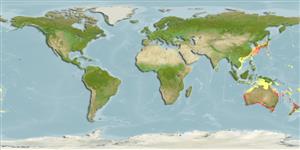>
Eupercaria/misc (Various families in series Eupercaria) >
Callanthiidae (Splendid perches)
Etymology: Callanthias: Greek, kalos, kallos = beautiful + Greek, anthias = a fish (Sparus aurata) (Ref. 45335).
More on author: Ogilby.
Environment: milieu / climate zone / depth range / distribution range
Écologie
marin récifal; profondeur 15 - 365 m (Ref. 9832). Subtropical
Western Pacific: off New Zealand and temperate waters off Australia; also known from one collection made northeast of Rockhampton, Queensland, Australia, and from one collection in the Chesterfield Island region of the Coral Sea; may reach Indonesian waters. Closely related to Callanthias japonicus from Japanese waters and from Callanthias platei from the southeast Pacific; all three taxa may be subspecies of a single wide-ranging species.
Taille / Poids / Âge
Maturity: Lm ? range ? - ? cm
Max length : 49.0 cm SL mâle / non sexé; (Ref. 33839); common length : 18.0 cm SL mâle / non sexé; (Ref. 9832)
Épines dorsales (Total) : 11; Rayons mous dorsaux (Total) : 10 - 12; Épines anales: 3; Rayons mous anaux: 10 - 11; Vertèbres: 24. Continuous dorsal fin, typically 11 dorsal- and anal-fin rays, and an emarginate caudal fin with elongate outer rays (Ref. 33616).
A schooling species which seeks the cover of caves and crevices at night and when disturbed. Often found on rocky reefs in coastal waters (Ref. 33616). Presumably feed on plankton.
Life cycle and mating behavior
Maturité | Reproduction | Frai | Œufs | Fécondité | Larves
Anderson, W.D. Jr., 1999. Callanthiidae. Groppos, goldies, splendid perches. p. 2553-2556. In K.E. Carpenter and V.H. Niem (eds.) FAO species identification guide for fishery purposes. The living marine resources of the Western Central Pacific. Volume 4. Bony fishes part 2 (Mugilidae to Carangidae). FAO, Rome. (Ref. 9832)
Statut dans la liste rouge de l'IUCN (Ref. 130435: Version 2024-2)
Menace pour l'homme
Harmless
Utilisations par l'homme
Pêcheries: sans intérêt
Outils
Articles particuliers
Télécharger en XML
Sources Internet
Estimates based on models
Preferred temperature (Ref.
123201): 13.7 - 22.5, mean 15.9 °C (based on 164 cells).
Phylogenetic diversity index (Ref.
82804): PD
50 = 0.5039 [Uniqueness, from 0.5 = low to 2.0 = high].
Bayesian length-weight: a=0.00977 (0.00379 - 0.02521), b=3.08 (2.86 - 3.30), in cm total length, based on LWR estimates for this (Sub)family-body shape (Ref.
93245).
Niveau trophique (Ref.
69278): 3.1 ±0.30 se; based on food items.
Fishing Vulnerability (Ref.
59153): Moderate vulnerability (44 of 100).
Nutrients (Ref.
124155): Calcium = 29 [16, 48] mg/100g; Iron = 0.732 [0.435, 1.198] mg/100g; Protein = 19.4 [18.4, 20.5] %; Omega3 = 0.23 [0.13, 0.38] g/100g; Selenium = 28.8 [14.3, 55.3] μg/100g; VitaminA = 43.2 [15.2, 123.7] μg/100g; Zinc = 0.808 [0.545, 1.159] mg/100g (wet weight);
